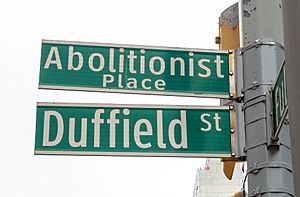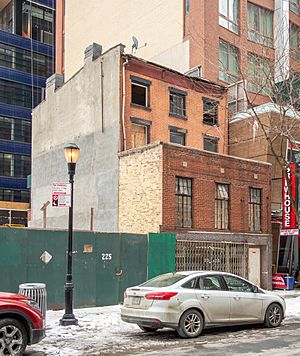Abolitionist Place facts for kids
Abolitionist Place is a special part of Duffield Street in Brooklyn, New York City. This area was very important in the 1800s for people who fought against slavery, known as abolitionists.
Abolitionists Harriet and Thomas Truesdell lived at 227 Duffield Street. Many believe their home was a stop on the Underground Railroad. This was a secret network that helped enslaved people escape to freedom. Another important person, William Harned, who helped on the Underground Railroad, lived nearby. Stories have been passed down about other houses on the street also being involved.
In the mid-2000s, the New York City Economic Development Corporation planned to tear down these historic sites. They wanted to build a new public park and underground parking. But many people in the community fought against these plans. Because of this strong opposition, the city renamed the street Abolitionist Place. However, they still moved forward with their development plans. By 2019, almost all the buildings linked to abolitionist activity on the street were torn down. Only 227 Duffield Street remained. In 2021, this last house was officially protected as a landmark by the New York City Landmarks Preservation Commission.
Contents
Why This Place is Special
Brooklyn was a very active place for people fighting against slavery before the American Civil War. Slavery was made illegal in New York in 1827. Brooklyn's location near the water made it a good spot for enslaved people to arrive by boat. They would then travel along secret routes of the Underground Railroad. Places like the nearby Plymouth Church were also part of this network.
Some people stayed in Brooklyn, while others continued their journey north. The Fugitive Slave Act of 1850 made it illegal to help an escaped enslaved person. This meant that abolitionist activities had to be kept very secret. Stories about Underground Railroad activities in houses and tunnels under Duffield Street have been told through generations. These stories focus on the area between Fulton Street and Willoughby Street.
227 Duffield Street
The house at 227 Duffield Street is a three-story building. It was built around 1847-1850 in the Greek Revival style. From 1851 to 1863, it was home to the abolitionists Harriet and Thomas Truesdell. During this time, many believe it served as a stop on the Underground Railroad.
Harriet Truesdell (1786 – 1862) and Thomas Truesdell (1789 – 1874) were active abolitionists. They worked in New England before moving to Duffield Street. Harriet helped organize the Anti-Slavery Convention of American Women in Philadelphia in 1838. She was also the treasurer for the Providence Ladies Anti-Slavery Society. Thomas was a founder of the Rhode Island Anti-Slavery Society. Their friend, the famous abolitionist William Lloyd Garrison, even stayed with them in Brooklyn. He was on his way to the World Anti-Slavery Convention in London.
The belief that 227 Duffield Street was an Underground Railroad stop comes from several clues. These include old items found in the basement. Its closeness to other known stops, like the Bridge Street African Wesleyan Methodist Episcopal Church and Plymouth Church, also supports the idea. There is also a doorway and a sealed arch in the basement. These lead to a tunnel under the building. It's hard to prove these claims for sure. This is because such secret activities were not well recorded on purpose. In 1933, the owners added a store front to the first two floors. But the original look of the third floor can still be seen.
Other Important Properties
Lewis Greenstein, who owned the house at 233 Duffield Street for a long time, also said his home was involved in abolitionist work. He believed it was a "feeding station" for escaped enslaved people. He heard these stories from past tenants. He also found sealed-off exits in his basement. Greenstein felt that the hidden tunnels under Abolitionist Place, including 233 Duffield, were "common knowledge" for enslaved people seeking freedom.
Protecting History: Community Action
In 2004, the city announced a big plan to redevelop Downtown Brooklyn. This plan included the part of Duffield Street between Fulton Street and Willoughby Street. It meant tearing down buildings like 227 and 233 Duffield Street. The city wanted to build underground parking and a new public park called Willoughby Park.
Property owners, including Joy Chatel from 227 and Lewis Greenstein from 233, began fighting the demolition orders. They worked to show the historical importance of the buildings. The city hired a company to study the Underground Railroad activity at the sites. This report found evidence of tunnels between houses. It also said that 227 Duffield was "quite possibly involved" with the Underground Railroad. However, the report concluded there wasn't enough direct proof to stop the demolition. Many people criticized this conclusion. They argued that secret activities like the Underground Railroad would not have much written proof.
The disagreement grew in 2007. The city announced it would use eminent domain to take and tear down the buildings. Community groups, like Families United for Racial and Economic Equality (FUREE), joined Joy Chatel. They worked to save the site. Chatel filed a lawsuit to stop the seizure, and she won.
Because of the strong public pushback, Mayor Michael Bloomberg's administration set aside $2 million. This money was for projects honoring abolitionist history. Duffield Street was also given an official alternative name: Abolitionist Place.
However, the renaming did not protect the buildings. By 2019, 227 Duffield was the only house still standing. Joy Chatel had sold half of the property before she passed away in 2014. Her daughter later sold the other half. In June 2019, the new owner wanted to tear down 227 Duffield to build a new 13-story building.
Organizations like Circle for Justice Innovations and FUREE, along with activists, fought back. They pushed for the house to be made a landmark. This effort delayed the demolition. Protests continued into 2020, with slogans like "Black Landmarks Matter" and "#Save227Duffield". Many politicians, including Borough President Eric Adams and Mayor Bill de Blasio, supported the landmark idea.
In January 2021, the city announced a design for Willoughby Square Park. It would honor Brooklyn abolitionists. This design also expected 227 Duffield Street to be saved. Finally, in February 2021, the New York City Landmarks Preservation Commission officially made 227 Duffield Street a landmark. It is now known as the Harriet and Thomas Truesdell House.
See Also
- Streets of Brooklyn



